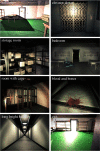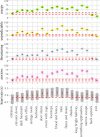The underwood project: A virtual environment for eliciting ambiguous threat
- PMID: 36289179
- PMCID: PMC10700233
- DOI: 10.3758/s13428-022-02002-3
The underwood project: A virtual environment for eliciting ambiguous threat
Abstract
Threatening environments can be unpredictable in many different ways. The nature of threats, their timing, and their locations in a scene can all be uncertain, even when one is acutely aware of being at risk. Prior research demonstrates that both temporal unpredictability and spatial uncertainty of threats elicit a distinctly anxious psychological response. In the paradigm presented here, we further explore other facets of ambiguous threat via an environment in which there are no concrete threats, predictable or otherwise, but which nevertheless elicits a building sense of danger. By incorporating both psychological research and principles of emotional game design, we constructed this world and then tested its effects in three studies. In line with our goals, participants experienced the environment as creepy and unpredictable. Their subjective and physiological response to the world rose and fell in line with the presentation of ambiguously threatening ambient cues. Exploratory analyses further suggest that this ambiguously threatening experience influenced memory for the virtual world and its underlying narrative. Together the data demonstrate that naturalistic virtual worlds can effectively elicit a multifaceted experience of ambiguous threat with subjective and cognitive consequences.
Keywords: Anxiety; Fear; Predictability; Uncertainty; Virtual worlds.
© 2022. The Author(s).
Figures




References
-
- Baird, R. (2000). The startle effect: Implications for spectator cognition and media theory. In film quarterly (Vol. 53, issue 3, pp. 12–24). 10.2307/1213732.
-
- Bates D, Maechler M, Bolker B, Walker S. Fitting linear mixed-effects models using lme4. Journal of Statistical Software. 2015;67(1):1–48. doi: 10.18637/jss.v067.i01. - DOI
MeSH terms
LinkOut - more resources
Full Text Sources
Medical

